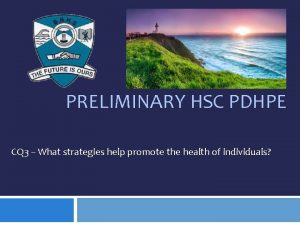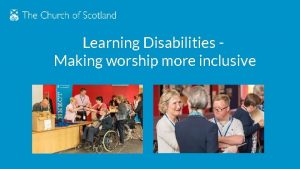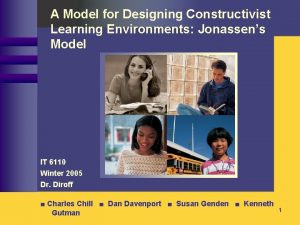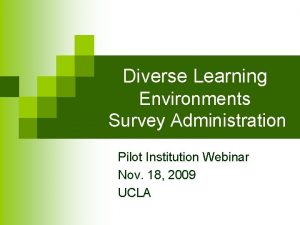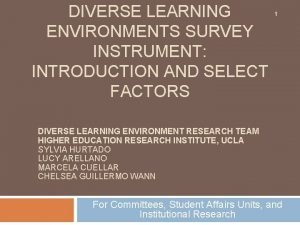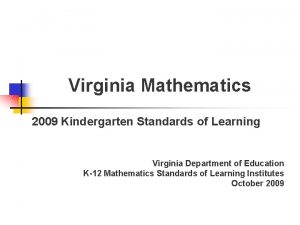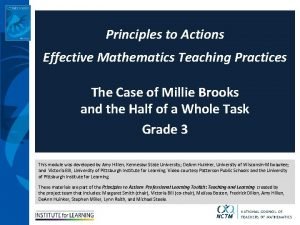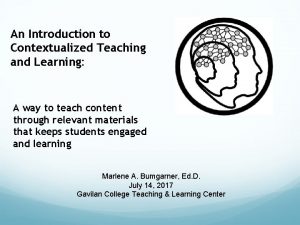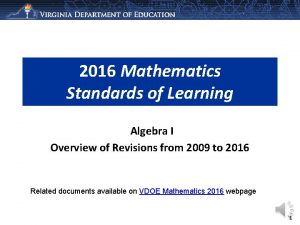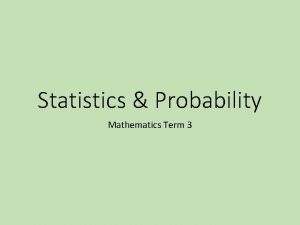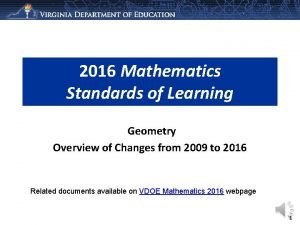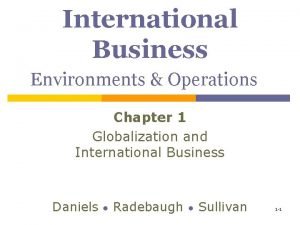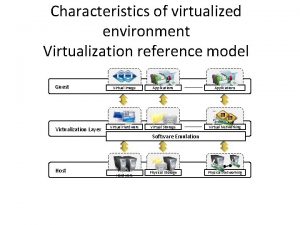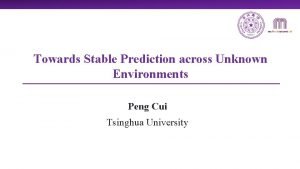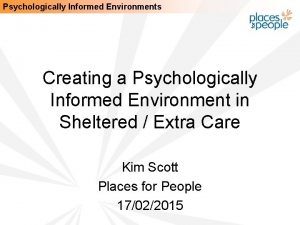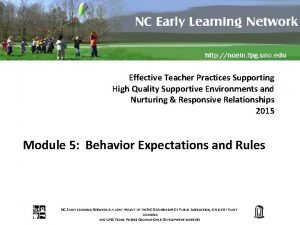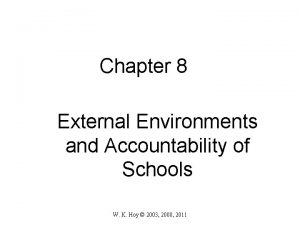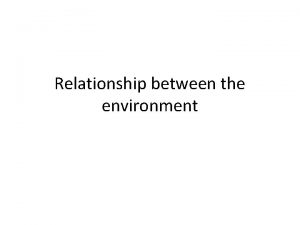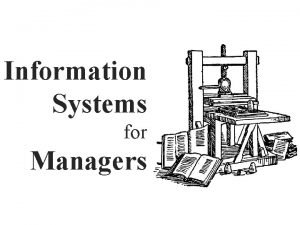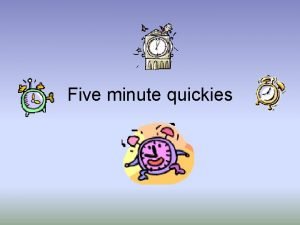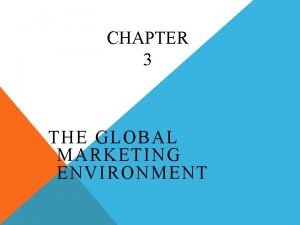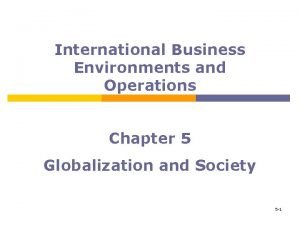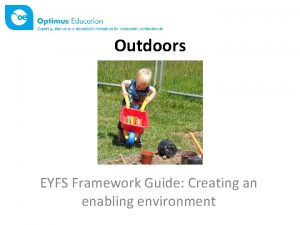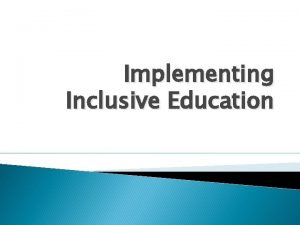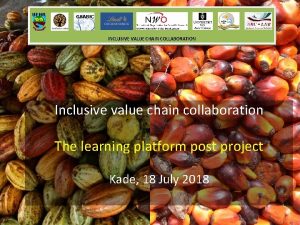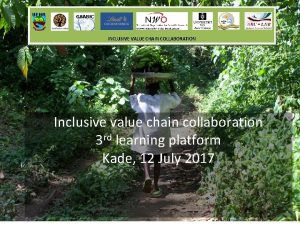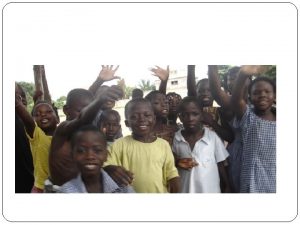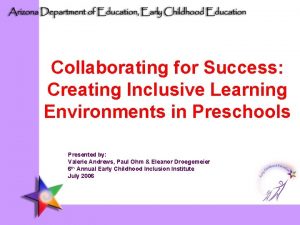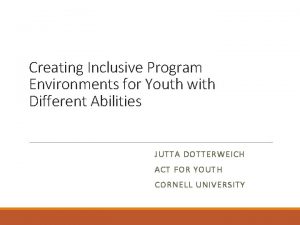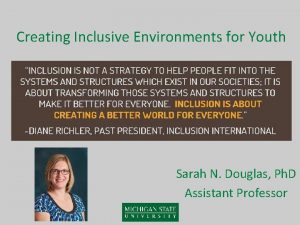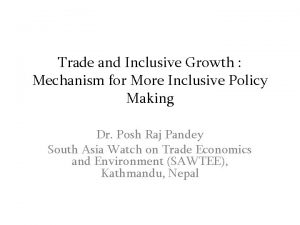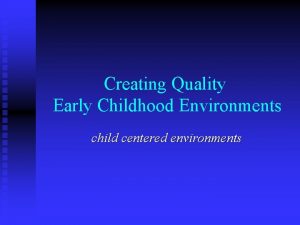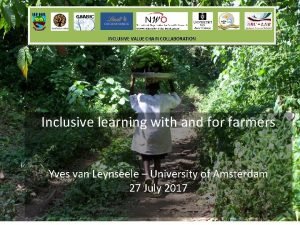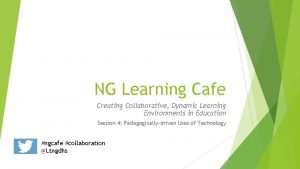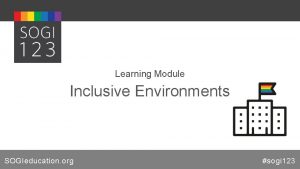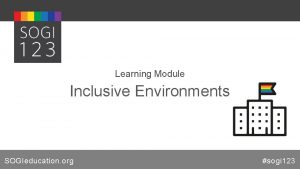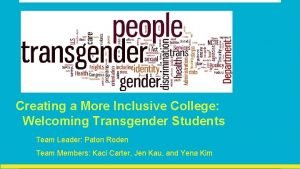Creating More Inclusive Learning Environments in Mathematics Insights


































- Slides: 34

Creating More Inclusive Learning Environments in Mathematics Insights from research for practice from the Mindset Scholars Network’s Inclusive Mathematics Environments Early Career Fellowship May 2020

Executive summary The Mindset Scholars Network, with the support of the Bill & Melinda Gates Foundation (BMGF), designed the Inclusive Mathematics Environments Early Career Fellowship to synthesize what decades of research reveals about creating inclusive environments for students from minoritized and marginalized groups in mathematics, with a focus on the middle childhood through mid-adolescence developmental stage. Between June 2019 and February 2020, 11 exceptional early career scholars, two faculty contributors, and a network of senior scholars who served as mentors / co‐authors selected topics that were of interest to them and their ongoing academic scholarship. One fellow was selected to create an interpretive summary for practice and policy audiences based on the other fellows’ academic syntheses. Mathematics as it is taught in K‐ 12 education reflects widely‐held but mistaken beliefs about the nature of mathematics and what it means to be good at mathematics. These beliefs manifest in curricular materials, assessment practices, and classroom interactions that privilege competition, speed, and accuracy over collaboration, critical thinking, and exploration. Disruptions due to COVID‐ 19 provide an opportunity to remove exclusionary barriers to learning and create more inclusive mathematics environments. The fellowship is grounded in an understanding that learning environments shape students’ opportunities to learn; directly, by affording or constraining access to instructional resources, and indirectly, by sending messages to students that shape the beliefs they develop about learning and school. These messages lead students to develop certain beliefs or mindsets about themselves and school, which influence the lenses through which students interpret experiences and shape their behaviors as a result. Inclusive learning environments foster a sense of belonging and help all students to develop their identity as competent and capable learners and to feel a sense of cultural continuity in that context. Advances in cognitive science and neuroscience demonstrate that inclusive environments create the conditions for brain activity that is necessary for learning, and multiple studies in diverse K‐ 16 contexts have shown that students’ concerns about belonging and ability can have a direct, causal effect on their educational outcomes including motivation, persistence on challenging tasks, course grades, test scores, and progression to graduation. To assess whether we belong in an environment, we draw on cues from both the proximal circumstances (e. g. , resources, practices, and relationships in that environment) and the broader context (e. g. , widely held beliefs and social norms). Broader racist and sexist beliefs about intelligence permeate schools and classrooms, and students from minoritized groups are more likely to bear the extra psychological weight of belonging concerns in those environments because they are aware how their group may be perceived and treated. Students and families who are subject to marginalizing and minoritizing forces can be keenly attuned to it and act in response. Such coping strategies mean students must conceal or alter aspects of themselves in order to be perceived as “fitting in” in mathematics environments, which may affect their mathematics identity development over time. 2

Executive summary, continued The fellowship papers suggest five interrelated guiding principles for creating more inclusive mathematics environments: • Mathematics educators need critical consciousness – i. e. , they understand how marginalization and bias are expressed in mathematics environments and work to actively counter it via their instructional choices and interactions with students. Examples of what educator critical consciousness can look like in practice include confronting homophobic language, employing complex instruction, explicitly praising the contributions of students who have a stigmatized identity in mathematics, or incorporating students’ uses of mathematics outside of school into their classwork. • Mathematics curriculum should reflect a more expansive view of mathematics, including the history of mathematical concepts, the uses of mathematics in different cultures, and the application of mathematics for understanding current events. Inclusive curricular materials represent the wide range of identities and communities that use mathematics and provide students with copious examples and opportunities to see how mathematical concepts are applied in the real world. • Mathematics curriculum and instruction should be adaptable so that it is relevant to the specific students in the class. This can take the form of using culturally responsive educational practices, welcoming students’ uses of their preferred language, and engaging students in choosing topics to study using mathematics. • Mathematics curriculum and instruction should feature meaningful opportunities to engage in collaborative work. Sharing their thinking in peer groups can support students’ mathematics identity development, and collaborative work promotes cultural continuity for students whose cultures value community and cooperation. • Assessment practices and policies should prioritize deep mathematical thinking, exploration, and collaboration. Traditional assessment practices in mathematics – which reflect and reinforce persistent, marginalizing notions linking mathematics aptitude with easily, quickly, and independently arriving at a correct answer – conflict with career mathematicians’ views of mathematics as highly social, collaborative, and grounded in intuition. The guiding principles are drawn from research on students’ experiences with and perceptions of mathematics. While these five principles represent clear themes that arose across multiple systematic literature reviews of dozens of studies over decades of research, some features of mathematics instruction and schools (e. g. , course tracking and access to rigorous coursework within and between schools) received lighter coverage across the papers and could be the focus of future efforts to understand what is known from the existing literature. There are many research gaps and urgent questions that remain, including connecting critical mathematics teacher practices in middle grades to longer‐run outcomes in mathematics, validating survey measures of known constructs with minoritized student populations, aligning assessments of mathematics learning with the demands of postsecondary and work environments, and operationalizing and implementing the guiding principles given the complexities of teaching and learning. In addition, MSN’s K‐ 12 Teachers & Classrooms Portfolio, also supported by BMGF, includes qualitative, descriptive, and quasi‐experimental studies that will help address key gaps in the research base that surfaced in the IME ECF. 3

Table of contents • Context on the Inclusive Mathematics Environments Early Career Fellowship (IME ECF) • Taking stock of the current educational context • Overview of research on the importance of learning environments • Guiding principles for creating more inclusive mathematics environments • Fellowship reflections and future directions for research • Works cited 4

Context on the Inclusive Mathematics Environments Early Career Fellowship (IME ECF)

Overview of the IME ECF • The Mindset Scholars Network, with the support of the Bill & Melinda Gates Foundation (BMGF), designed the Inclusive Mathematics Environments Early Career Fellowship to conduct a cross-cutting, interdisciplinary review of decades of research relevant to creating inclusive learning environments in mathematics, bridging scholarship in psychology and sociology with that from mathematics education. • Between June 2019 and February 2020, 11 exceptional early career scholars, two faculty contributors, and a network of senior scholars who served as mentors / co‐authors synthesized what research reveals about creating inclusive environments for students from minoritized and marginalized groups in mathematics, with a focus on the middle childhood through mid-adolescence developmental stage. • Within the broad conceptual parameters of the fellowship, fellows selected topics that were of interest to them and their ongoing academic scholarship. One fellow was selected to create an interpretive summary for practice and policy audiences based on the other fellows’ academic syntheses. • Fellows were provided with a breadth of supports during the fellowship from the fellowship director Shanette Porter, MSN staff, faculty director Tanner Le. Baron Wallace, faculty contributors, mentors, and external reviewers. These supports shaped their fellowship output (i. e. , paper) and cultivated their broader professional identity, skills, and network, which will have long‐term impacts on the fellows themselves and the scholarly community beyond the end of the fellowship. These included: – Opportunities to participate in virtual writing workshops with the fellowship leadership on best practices for conducting a research synthesis using a systematically constructed data set of literature to advance a novel argument – Engaging in an online community via Slack where they could ask questions and solicit feedback informally from each other and the fellowship team; this contributed to a culture of relationships, support, vulnerability, and transparency that led to creative idea generation – Multiple formal opportunities for tailored feedback to build their skill at interdisciplinary and critical scholarship * and hone the substance of their syntheses, including repeated rounds of feedback and revision of their argumentation outline and multiple drafts, and a small group discussion session with fellowship leadership focused on advancing their sophistication around interdisciplinarity in particular – Presenting their in-progress work to BMGF staff, which offered an unusual chance for early career researchers to get a “peek behind the curtain” in understanding philanthropy, and an opportunity to begin thinking about practical implications of their work at a systems level *Critical scholarship examines the role of power in creating and maintaining oppressive and exclusionary systems. 6

IME ECF Fellowship Leadership and Advisors Fellowship leadership Shanette Porter, MSN, Fellowship Director Tanner Le. Baron Wallace, Pittsburgh, Faculty Director Fellowship advisors Deborah Loewenberg Ball, Michigan, Advisor Maisie Gholson, Michigan, Advisor De. Leon Gray, North Carolina State, Advisor Luis Leyva, Vanderbilt, Advisor Jamaal Matthews, Montclair State, Advisor Na’ilah Suad Nasir, Spencer Foundation, Mentor 7

IME ECF Fellows / Mentors and Faculty Contributors (*) Priyanka Agarwal, UC Irvine Tesha Sengupta‐ Irving, Vanderbilt Nicole Williams Beechum, UChicago Camille Farrington, UChicago Grace Chen, Vanderbilt Jessica Gladstone, New York University Stacy Priniski, Michigan State Anthony Johnson, Harvard Jennifer Langer‐ Osuna, Stanford Katie Kroeper, Indiana Mary Murphy, Indiana Matthew Voigt, San Diego State Ilana Horn, Vanderbilt Dana Miller‐Cotto, UC San Francisco Neil Lewis, Jr. , Cornell Charles Wilkes, Michigan Andrei Cimpian, New York University Nickolaus A. Ortiz, Georgia State Nathan N. Alexander, Morehouse * Maisie Gholson, Michigan Dustin Thoman, San Diego State Daniel Lee Reinholz, San Diego State Deborah Loewenberg Ball, Michigan * Luis Leyva, Vanderbilt 8

Guiding questions for the IME ECF syntheses Guiding questions pursued by the fellows: Agarwal: How do young girls and sexually minoritized youth come to resist (or actively disrupt) epistemic bias influenced by genderism and sexism during mathematics classes? Miller-Cotto: What are the relationships among classroom opportunities, learning processes, and Black and Latinx identities in mathematics? Chen: By what processes do marginalization and exclusion happen in mathematics classrooms, and what does that suggest about how to not only mitigate or resist/challenge marginalization and exclusion but to imagine something new? Ortiz: What forms of capital do Black students possess that could be advantageous to the learning of mathematics? Gladstone: What factors shape the effectiveness of role models in supporting the development of positive identity and psychological experiences in mathematics, particularly for students who have been minoritized in mathematics? Johnson: How does the culture of STEM environments—as expressed through norms and practices—facilitate or impede inclusion based in social class, race or ethnicity, and gender? Kroeper: What strategies can teachers use to foster identity safe mathematics classrooms for their students that belong to groups typically devalued and/or underrepresented in mathematics contexts? Priniski: What strategies can teachers use to create content and spaces that are responsive to all of the learners in their classrooms? Voigt: What are the experiences of queer and trans‐spectrum students in mathematics and STEM environments and what are the factors that contribute to inclusive mathematics environments for queer spectrum students? Wilkes: What features of mathematics environments nurture positive mathematical identities for Black learners? Williams Beechum: [Interpretive Summary] What is student success in mathematics and what matters for the success of minoritized student learners in mathematics environments? Guiding questions pursued by the faculty contributors: Gholson: How might the narrow current construction of school mathematics mediate children’s relationship to the discipline of mathematics? How might a more robust rendering of mathematics through the humanities develop more meaningful, deeper, and long‐lasting relationships to mathematics? Leyva: What relationships exist between how equity has been studied in mathematics education and higher education? What implications does this raise for theorizing equity in the field of undergraduate mathematics education? 9

Taking stock of the current educational context

Disruptions due to COVID‐ 19 intensify the need to create inclusive environments that support exceptional learning COVID-19 has disrupted traditional schooling and is expected to substantially compromise students’ learning – especially in mathematics, according to recent analyses (Kuhfeld & Tarasawa, 2020). This moment offers funders and educational support organizations an opportunity: instead of striving to “catch up” to the academic expectations of three months ago, we can use this time to consider how we might restructure our education system to prioritize the students it wasn’t originally designed to serve and who remain furthest from opportunity. Research suggests that we can support exceptional learning when we address marginalization and exclusion and remove its psychologically-taxing and performance-inhibiting effects on students. Environments play an important role in learning, and so in pursuing more equitable outcomes for students we might ask to what extent mathematics environments recognize and reflect all students in the class, use their ways of thinking about and using mathematics as strengths to build upon, and celebrate their contributions to the classroom and to mathematics. Collectively, the fellowship papers underscore that for students with stigmatized identities in mathematics, this is rarely the case. In contrast, white, middle‐ and upper‐class students, especially boys and men, disproportionately have access to teachers who understand their community and cultural backgrounds, curriculum that reflects the contributions, language, practices, and experiences of people who look like them, and assessments that align with their cultural values of individual achievement (Agarwal, 2020; Chen & Horn, 2020; Kroeper & Murphy, 2020; Ortiz, 2020; Voigt & Reinholz, 2020). These features of the learning environment offer advantages to these students on top of the material, financial, and social capital benefits conferred to them. Students from minoritized and marginalized groups are expected to learn and develop mathematics identities in exclusionary spaces where they are not valued or authentically included. To create more equitable and inclusive learning environments, we must attend to students’ experiences in those environments (Williams Beechum, 2020). With school buildings across the country closed, the primary learning environment for academic content has moved from the classroom to students’ homes. We must therefore learn to transform not only traditional in‐person environments, but also virtual and remote learning environments. 11

Marginalization and exclusion have been the status quo in education, and especially so in mathematics Marginalization is the process by which some groups are viewed as less valuable and relevant than others, often in ways that reflect and reproduce historical power relations and social hierarchies (Chen & Horn, 2020). Marginalization is both material and ideological and is supported by exclusionary structures and practices that deny resources and opportunities to individuals and groups (Chen & Horn, 2020). Segregation of schools by race and socioeconomic class of the surrounding community and divestment of resources to schools serving minoritized communities leads to lower outcomes which then reinforce the racist and classist narratives which led to the segregation and divestment (Chen & Horn, 2020; Kroeper & Murphy, 2020; Miller‐Cotto & Lewis, 2020). Marginalization reflects and reinforces beliefs about whose knowledge, contributions, language, and practices are considered “credible” and “worthy” and whose are “deficient” and “irrelevant. ” In the context of mathematics education, the knowledge, contributions, language, and practices associated with white, Western, and male‐dominated societies are considered uniquely credible and worthy, which marginalizes Black, Latinx, and Native American students, students from families facing economic disadvantage, students who are multilingual learners, and girls. Mathematics as it is taught in K-12 education reflects widely-held but mistaken beliefs about what it means to be good at mathematics. These beliefs manifest in curricular materials, assessment practices, and classroom interactions that privilege competition, speed, and accuracy over collaboration, critical thinking, and exploration. While mathematicians view mathematics as a cultural, prosocial, and ever-evolving body of knowledge and practices, the mathematics content covered in most K-12 courses represents a much narrower view of the nature of the discipline (Agarwal, 2020; Chen & Horn, 2020; Gholson, 2020). Marginalization and exclusion in mathematics are particularly detrimental because mathematics aptitude is commonly viewed as a sign of general intelligence (Leslie, Cimpian, Meyer, & Freeland, 2015; Shah, 2017). Mathematics is also used as a gatekeeper for access to postsecondary education, economic opportunity, and full citizenship (Moses & Cobb, 2001). In this moment, which calls for unprecedented learning in the wake of the impacts of COVID 19, we will need to remove the exclusionary barriers to learning that are the status quo in mathematics environments. “…mathematics is used to legitimize and perpetuate inequity, because standardized tests convert or sanction privilege into “intelligence. ” Equating mathematics with intelligence has a longstanding racist and ableist history in its use with IQ testing, which was used to “prove” the inferiority of some populations (Persell, 1981). In this way, the discipline of mathematics has been used to further oppressive endeavors throughout much of history by associating lower mathematical performance with minoritized identities (Shah, 2019). ” (Voigt & Reinholz, 2020) 12

Overview of research on the importance of learning environments

Inclusive environments foster learning Humans are born to be learners and doers. While many factors are at play, our psychological experiences—including feelings of competence, connection to others, and being seen and heard—fuel the desire to learn. These psychological experiences are shaped by our environments, both the proximal conditions and broader structural and societal contexts. In formal education, learning environments include classroom conditions such as teacher‐student interactions, curricular materials, and instructional practices, but also more distal factors such as school and system policies and broader social beliefs and norms. Inclusive learning environments foster a sense of belonging – the perception that one is valued and respected in a given context – for all students. They help all students to develop their identity as competent and capable learners and to feel a sense of cultural continuity in that context. The fellowship papers offer a vision of inclusive mathematics learning environments that: • Authentically engage all students in the richness and complexity of mathematics • Support all students in developing a mathematics identity • Are culturally relevant to all students, offering both ‘windows’ and ‘mirrors’ to different cultural perspectives • Hold students and families as vital partners in learning Such environments support students to feel a sense of belonging in mathematics, develop a mathematics identity, and access rich mathematics learning opportunities and coursework. Mathematics identity is “one’s sense of belonging to the mathematics community, a sense of achievement based on the norms of the mathematics community, and specific behaviors that are associated with members of the mathematics community” (Boaler et al. , 2000 in Miller‐Cotto & Lewis, 2020). Mathematics identity development is shaped by recursive processes where experiences of success and failure inform students’ sense that they are a ”math person, ” which in turn influences their motivation and the likelihood that they will engage in future mathematics activities (Miller‐Cotto & Lewis, 2020; Bem, 1972). Students with a stronger sense of mathematics identity persist longer in challenging mathematics activities and coursework (Boaler & Greeno, 2000). When students have not yet developed a robust mathematics identity, they are more likely to have belonging concerns than their peers who have a strong mathematics identity (Cheryan & Plaut, 2010; Steele, 1997). Cultural continuity is “a pattern of norms and standards that manifest in the lives of ethnic groups across geographic locales and over time” (Gray et al. , 2020). Because all learning is influenced by and imbued with cultural meaning (Nasir et al. , 2006), students may be unable to leverage the knowledge and skills they developed outside of school in learning environments that are culturally disconnected from the rest of their lives (NAS, 2018). A cultural disconnect can make it difficult for students to develop a mathematics identity because they must reconcile their views of themselves with the mathematics identities that are portrayed in school mathematics (Cobb & Hodge, 2010). 14

Our brains are wired to learn under such conditions Advances in cognitive science and neuroscience suggest that inclusive environments can help create the necessary conditions for learning (NAS, 2018). When students believe that they can be successful and feel valued and seen by their teachers and peers in a learning environment, they can put the full weight of their cognitive resources behind what they are doing. When students worry that they don’t “have what it takes” to be successful, are concerned that they don’t belong, or believe they can’t reveal their full, authentic selves in a situation, their attention and cognitive resources get divided between the task at hand evaluating cues as to whether they can be successful, belong, and are valued in that environment. Adolescent brains are both particularly malleable and sensitive to social cues and relationships, making inclusive classroom environments especially important during this period of development (Galván, 2014; Juvonen, 2006; NAS, 2019). Over time, persistent and pervasive worries about belonging can lead people to disengage and disidentify with a given context (Walton & Cohen, 2007). Multiple studies in diverse K-16 contexts have shown that students’ concerns about belonging and ability can have a direct, causal effect on near- and long-term educational outcomes, including their motivation, persistence on challenging tasks, course grades, test scores, and progression to graduation (Carr & Walton, 2017; Master, Cheryn, & Meltzoff, 2017; Walton & Wilson, 2018; Yeager et al. , 2017, Yeager et al. , 2019). “Emotion and cognition are supported by interdependent neural processes. It is literally neurobiologically impossible to build memories, engage complex thoughts, or make meaningful decisions without emotion…. Put succinctly, we only think about things we care about. ” (Immordino‐Yang, 2015, p. 18) “Our brains are constantly bombarded by sensory inputs… so some filtering is done before incoming information or experiences get to areas like the prefrontal cortex, where executive functioning and higher-order thinking take place, and the hippocampus, where memory tasks begin… The [amygdala and our limbic system] plays a key role… as our emotional filter. When we are under stress, it directs sensory intakes to our rear ‘reactive brain’ where our ‘fight, flight, or freeze’ response is embedded… However, when we are under no or low stress, the limbic system… directs sensory intakes to the prefrontal cortex, home of executive functioning and higher order thinking. Our thinking, organizing, planning, and problemsolving skills are unleashed on those sensory inputs, so we are primed to learn. ” (Whitman & Kelleher, 2016, pp. 67‐ 68) 15

How we make meaning of our environments affects our motivation, behaviors, and outcomes Learning environments shape students’ opportunities to learn; directly, by affording or constraining access to instructional resources, and indirectly, by sending messages to students that shape the beliefs they develop about learning and school. These messages may affect students both in the moment and over time. That is, the residue of repeated messages accrues over time and leads students to develop certain beliefs or mindsets about themselves and school. These beliefs are the lenses through which students interpret experiences and shape their behaviors as a result. When a student feels they belong in mathematics class, they are more likely to remain engaged in the work of that class. Beliefs get reinforced over time through recursive cycles between individuals and the environment. For example, when students feel valued by their teachers or see their schoolwork as relevant, they are more likely to become more engaged in their academic work, and their teachers are more likely to respond to them positively in turn. Conversely, when students worry about whether they can be successful or whether their teacher respects them as a learner, they can be less likely to seek help from their teachers, who may in turn perceive the student as “unmotivated” and withhold attention or opportunities. Students and families who are subject to marginalizing and minoritizing forces can be keenly attuned to it (Miller‐Cotto & Lewis, 2020) and act in response. These responses can take the form of assimilation; in mathematics, this could include, for example, girls endorsing meritocratic beliefs as a way to feel valued in a patriarchal society (Agarwal, 2020), Black students engaging in “impression management” to appear nonthreatening and avoid being perceived as defiant (Agarwal, 2020), or queer students remaining closeted in mathematical spaces to prevent being targeted or making other students uncomfortable (Voigt & Reinholz, 2020). While some educators may perceive this as adaptive behavior, such coping strategies mean students must conceal or alter aspects of themselves in order to be perceived as “fitting in” in mathematics environments, which may affect their mathematics identity development over time. Alternatively, student responses can take the form of resistance to being marginalized, such as students and parents advocating for access to advanced coursework (Ortiz, 2020). It can also be seen when students willfully disengage from a class as a means of rejecting the white, heteronormative culture and ways of interacting that characterize school mathematics (Ortiz, 2020; Voigt & Reinholz, 2020) or avoid gendered bias by retreating to girls‐only groups or contexts (Agarwal, 2020). Example of recursive processes sparked by cues in the environment and effects on outcomes: In a field experiment, teachers edited 7 th grade students’ essays and then researchers randomly assigned one of two post ‐it notes, written by the teacher, to the essay before it was handed back. The treatment post‐it assured students of their teachers’ high expectations for them and their belief that they could meet them; the control group‐post it merely said that the teacher had given them these comments so they’d have feedback. The results: Black students were over 3 x more likely to resubmit their essay if they received the treatment note from their teacher and received higher scores on the revised essay even though teachers had no idea which note they had received. Moreover, reducing belonging concerns had long‐term effects: Black students who received the treatment note had fewer discipline citations the following year and were more likely to have enrolled in a 4 -year college 6 years later (Yeager et al. , 2017). 16

Environments send myriad messages and for marginalized students, recurrent messages are often negative To assess whether we belong in an environment, we draw on cues from both the proximal circumstances (e. g. , resources, practices, and relationships in that environment) and the broader context (e. g. , widely held beliefs and social norms). In academic settings, teachers and peers offer some of the most readily apparent feedback to students about their belonging. However, belonging is more than a welcoming classroom climate and affirming interpersonal relations. Broader racist and sexist beliefs about intelligence permeate schools and classrooms (Ball, 2020), and students from minoritized groups are more likely to bear the extra psychological weight of belonging concerns in those environments because they are aware how their group may be perceived and treated. While all students tend to experience declines in belonging during adolescence, students of color tend to exhibit sharper declines (Wang & Eccles, 2012), particularly in mathematical spaces (Spencer, 2009). Recent scholarship explores the opportunity structures that foster a sense of belonging through instructional practices and materials and through school and systems-level policies, as well (Gray, Hope, & Matthews, 2018). For example, curricular materials that neglect or altogether ignore the contributions of minoritized groups and policies such as tracking, which disproportionately limits these students’ access to rigorous coursework and instruction, send repeated signals to students about their belonging in classroom environments, the residue of which accumulate over time in profound ways and shape students’ beliefs about themselves and school—in addition to limiting material access to educational resources and opportunity. These opportunity structures systematically afford belonging to privileged students and hinder belonging to minoritized students. Approaches that are hypothesized to create conditions for belonging at multiple levels (Gray, Hope, & Matthews, 2018) – addressing classroom‐level signals, institutional structures, and broader narratives about minoritized groups – over an extended period of time have shown large effects on academic performance and outcomes, compared to most other rigorously evaluated education interventions: • Participation in SFUSD’s 9 th grade ethnic studies course increased attendance by 21 percentage points, credits earned by 23 (~4 courses), and GPAs by 1. 4 points (Dee & Penner, 2017). • The African American Male Achievement initiative in Oakland Unified School District increased one‐year persistence for Black male high school students by 3. 6 percentage points and increased their graduation rate by 3. 2 percentage points (Dee & Penner, 2019). Together, this scholarship suggests that inclusive environments require addressing prejudice in both people and places (Murphy et al. , 2018; Murphy & Walton, 2013). 17

Guiding principles for creating more inclusive mathematics environments arising from the IME ECF

Guiding principles for creating more inclusive mathematics environments The IME ECF papers offer insights into the messages students receive in mathematics, where these messages emanate from or are reinforced, and how we might alter the messages to be more inclusive. To make the experience of mathematics inclusive for students from groups that have been marginalized in mathematics for generations, we must attend to the practices, structures, and policies that shape students’ experiences in mathematics on a daily basis and send consistent, repeated signals to students and teachers about who belongs in mathematics, whose knowledge is relevant, and who is expected to succeed. The fellowship papers suggest five interrelated guiding principles for creating more inclusive mathematics environments: 1. Mathematics educators need critical consciousness 2. Mathematics curriculum should reflect a more expansive view of mathematics: its history, participants, and applications 3. Mathematics curriculum and instruction should be adaptable so that it is relevant to the specific students in the class 4. Mathematics curriculum and instruction should feature meaningful opportunities to engage in collaborative work 5. Assessment practices and policies should prioritize deep mathematical thinking, exploration, and collaboration The following slides take up each of these principles in course. Underlying the principles are two common themes: • All students have mathematical knowledge and skills that educators can leverage. Educators who recognize that students are experts on their own uses of mathematics, including how they use mathematics outside of school, can engage students as key contributors to their own learning, rather than as empty vessels to be filled (Ortiz, 2020; Priniski & Thoman, 2020). • Students are individuals and the experience of being marginalized is not the same for all students, even those from the same demographic group. This is in part due to intersectional identities encompassing everything from their race, gender, and socioeconomic class to their sexuality, religion, and age and further individualized by students’ geographic region, home language, immigration experiences, and family influences (Wilkes & Ball, 2020; Chen & Horn, 2020; Collins & Bilge, 2010; Voigt & Reinholz, 2020; Ortiz, 2020). This interaction between individual and context means that an educator's approach needs to be attuned to the experiences and perspectives of the students in their class. 19

1. Mathematics educators need critical consciousness Educators who are critically conscious take a historical perspective on how capitalism, racism, poverty, and gentrification shaped the communities their students now live in (Love, 2020). Critically conscious educators use this knowledge to more carefully attend to the explicit and implicit messages they convey to students about their mathematics identity and capabilities as mathematics learners (Agarwal, 2020; Miller‐ Cotto & Lewis, 2020; Ortiz, 2020; Voigt & Reinholz, 2020). They apply this perspective to build relationships with their specific group of students and respond to interactions between students (Agarwal, 2020; Ortiz, 2020; Priniski & Thoman, 2020; Voigt & Reinholz, 2020). Critically conscious mathematics educators understand how marginalization and bias are expressed in mathematics environments (Chen & Horn, 2020; Kroeper & Murphy, 2020; Leyva, Balmer & Mc. Neill, 2020) and work to actively counter it via their instructional choices and interactions with students. The fellowship papers offer examples of what critical consciousness can look like in practice: • Explicitly conveying high expectations for students (Kroeper & Murphy, 2020; Ortiz, 2020). It is important to note that research suggests that holding high expectations for all students may not be sufficient to impact students: students whose teachers held high expectations and an asset-based, critical consciousness scored higher on mathematics standardized tests than students of teachers who held high expectations alone (Matthews & López, 2019) • Creating space for students with marginalized sexual identities by confronting homophobic language and using inclusive language within the classroom (Voigt & Reinholz, 2020) • Employing complex instruction (Cohen et al. , 1999), which uses structured small group collaborations to disrupt status hierarchies and can, for example, engage students in identifying how gender or other social identities play out in the classroom (Agarwal, 2020) • Publicly and authentically recognizing and praising the contributions of students who have a stigmatized identity in mathematics or whose mathematical contributions have been belittled by their peers (Agarwal, 2020; Chen & Horn, 2020; Kroeper & Murphy, 2020; Ortiz, 2020; Voigt & Reinholz, 2020; Wilkes & Ball, 2020) • Positioning students as mathematicians by providing opportunities to experience meaningful mathematical success and incorporating students’ uses of mathematics outside of school into their classwork, so that students see their own behavior as “what mathematicians do” (Miller‐Cotto & Lewis, 2020; Ortiz, 2020; Voigt & Reinholz, 2020) The fellowship papers also offer ideas on how teacher preparation programs and professional learning providers can support pre‐service and in‐ service teachers in developing and sustaining a critical consciousness, such as: • Proactive confrontation, in which teachers or teacher candidates are made aware of how bias can manifest in mathematics environments and how it can affect students (Kroeper & Murphy, 2020). This can have the dual effects of reducing expressions of bias and shifting attitudes and beliefs to be less biased (Carnes et al. , 2015; Chaney & Sanchez, 2018; Czopp et al. , 2006; Devine et al. , 2012, 2017; Forscher et al. , 2017) • Video Interventions for Diversity in STEM (VIDS) are short videos summarizing published research on gender bias that have been shown to increase positive attitudes toward women in STEM and increase intentions to promote gender parity (Moss‐Racusin et al. , 2018 in Agarwal, 2020) 20

2. Mathematics curriculum should reflect a more expansive view of mathematics: its history, participants, and applications Like other domains, mathematics as a discipline is historical, political, and cultural but, in contrast to disciplines like the humanities or social studies, school mathematics is treated as though it exists—and always has existed—outside of human experience and influence (Gholson, 2020; Priniski & Thoman, 2020). Humanizing mathematics would provide more holistic coverage of mathematics as a subject, including the history of mathematical concepts, the uses of mathematics in different cultures, and the application of mathematics for understanding current events. This more complete scope would create additional entry points for students to take an interest in mathematics and increase the opportunities for students to see the relevance of mathematics to their community, broader society, and their own lives. To create more inclusive mathematics environments, curriculum materials must extend beyond their current scope to: • Provide students with the historical, political, and cultural background of mathematical concepts (Gholson, 2020; Leyva, Balmer & Mc. Neill, 2020; Ortiz, 2020). For example, despite being documented in a 1 st century Chinese text, it wasn’t until the mid 19 th century that negative numbers were a formally accepted mathematical concept (Berlinghoff & Gouvea, 2002 in Gholson, 2020). Exploring this cultural‐historical background offers students a much broader set of footholds into mathematics than simply teaching the law of signs. • Represent the wide range of identities and communities that use mathematics (Priniski & Thoman, 2020; Ortiz, 2020) as a means to counter stereotypes and offer a more expansive vision of who can be a mathematician (Gladstone & Cimpian, 2020; Voigt & Reinholz, 2020). This can include, for example, word problems that describe non‐nuclear families (Voigt & Reinholz, 2020) or involve students documenting their families’ uses of fractions and measurement when cooking or doing other activities outside of school. • Provide copious examples and opportunities to see how mathematical concepts are applied in the real world. * This can increase the value students see in learning and doing mathematics (Matthews, 2018). For example, a unit on linear equations can ask students to assess household expenses to construct an argument about what a local minimum wage should be (Dean, 2013 in Priniski & Thoman, 2020). *This is also supported by the Common Core State Standards, which state that students should be able to “apply the mathematics they know to solve problems arising in everyday life, society, and the workplace. ” “Put succinctly by Gutiérrez (2008): ‘A single curricular activity might serve as a ‘mirror’ for some students while opening up a ‘window’ to a different world for others…The goal should not be finding those activities that best fit the identities of a given student population in an essentialistic way but rather striking a balance between the number of windows and mirrors provided to a student’ (p. 360). That is, White students tend to experience examples as a mirror in their math classes—the examples reflect themselves and their experiences—and so they feel at home in math environments; whereas, Black, Latino, and Native students tend to experience those examples as a window through which they see the experiences of their White peers. ” (Kroeper & Murphy, 2020) 21

3. Mathematics curriculum and instruction should be adaptable so that it is relevant to the specific students in the class Too often, school mathematics is not made personally relevant (including culturally) for marginalized students, which can limit how pertinent they perceive mathematics to be to their lives (Priniski & Thoman, 2020). The absence of their culture, language, and community in their mathematics schoolwork can signal to students that their identity doesn’t align with what it means to be a mathematician (Miller‐Cotto & Lewis, 2020). Ways of knowing and expressing knowledge of mathematics can vary by culture and background (González et al. , 2005). Educators must engage with students and their families to tap into these funds of knowledge and make mathematics more relevant for students (Priniski & Thoman, 2020). To create more inclusive mathematics environments, curriculum materials and instruction should be adapted and/or supplemented to leverage the unique mathematical identities and uses of mathematics of the students and communities represented in the classroom. This can include: • Using culturally responsive educational practices, which capitalize on “the cultural knowledge, prior experience, frames of reference, and performance styles of ethnically diverse students to make learning encounters more relevant to and effective for them” (Gay, 2010) and can convey to students that they are capable and valued as individuals and mathematics learners while being their authentic selves (Kroeper & Murphy, 2020). In doing so, it is important that student populations, even those with shared backgrounds or demographic characteristics, are not treated as monoliths. • Welcoming students’ uses of their preferred language to explain their mathematical thinking. For example, students using African American Vernacular English can convey complex mathematical ideas without needing to code switch (Martin et al. , 2019; Ortiz, 2020). Insisting that students use standard American English conveys disdain for students’ lives outside of school and can be an expression of racial and cultural bias (Kroeper & Murphy, 2020; Ortiz, 2020). • Engaging students in choosing topics to study using mathematics. Capitalizing on students’ uses and understandings of mathematics can make mathematics more interesting and relevant for students (Priniski & Thoman, 2020). Students may be more engaged when they can choose topics or issues that are important to them. • Using social justice approaches to teaching and learning mathematics, which use mathematics to explore socially‐ and culturally‐relevant current events and as a tool for advancing towards a more equitable society (Priniski & Thoman, 2020). For example, a unit on ratios might examine school overcrowding or the proportion of basketball courts to vacant lots in the community. “Even attempts to make mathematics more relevant can be problematic when textbooks have word problems crafted to be relevant for the ‘average’ (white, middle-class) student. Analysis of these examples reveals problematic content, including gender stereotypes and reinforcement of the social hierarchy (Lesser & Blake, 2007). For example, Trexler (2013) noted that problems about whether the daily bus fares or weekly bus passes are the less costly way to get to work required the assumption of a 5 -day work week typical of white-collar jobs in order to answer the question correctly. ” (Priniski & Thoman, 2020) “…culturally relevant and responsive pedagogies (Ladson-Billings, 1997; Corp, 2017) help us understand that what is relevant for Black children in Atlanta may not be culturally relevant for Black children in Detroit…” (Ortiz, 2020) 22

4. Mathematics curriculum and instruction should feature meaningful opportunities to engage in collaborative work Status quo instructional practices in mathematics often reflect Western, white, middle-class, stereotypically male ways of interacting and can signal to students that other ways of engaging with mathematics aren’t compatible with success or competence in mathematics (Chen & Horn, 2020; Kroeper & Murphy, 2020; Ortiz, 2020; Voigt & Reinholz, 2020). For example, applying a series of steps to arrive at a singular, correct answer is more culturally aligned for white students than Native American students, and others from more collectivist cultures, who may be more likely to prioritize community, connectedness, and multiple approaches to problem solving (Aikenhead, 2017). Similarly, working independently and in competition with others are associated with stereotypically masculine and Western ways of thinking (Agarwal, 2020; Chen & Horn, 2020), which can stand in contrast to the way many Black students (and others whose cultures prioritize community) are socialized outside of school (Ortiz, 2020). Sharing their thinking in peer groups can support students’ mathematics identity development (Miller‐ Cotto & Lewis, 2020), and collaborative work promotes cultural continuity for students whose cultures value community and cooperation (Gray et al. , 2020). A couple of recent studies have found that Black and Latinx students tended to show increased engagement during lessons that were more relevant to communal goals (i. e. , goals that prioritize the needs of the cultural group over individual needs; Gray et al. , 2020), and that working together improved the performance of students whose parents did not complete college (Dittmann, Stephens, & Townsend, 2020). Collaborative work needs to be thoughtfully designed and is not simply grouping students together to complete trivial tasks; rather, educators must ensure that students are engaged in rigorous mathematical inquiry with their peers. By carefully designing heterogenous groups and establishing norms around taking responsibility for each other’s learning, educators can foster equity and positive experiences across lines of difference. This can help students develop a sense of multidimensionality (i. e. , that there is more than one way to think about and solve a problem; Agarwal, 2020; Nasir et al. , 2014). Opportunities for collaborative work in mathematics have implications for students’ futures. Overly controlled and structured classroom experiences that limit peer interactions do not prepare students to meet the expectations for collaborative participation that they are likely to encounter in postsecondary education environments (Johnson, 2020). Minoritized students are more likely to endorse prosocial goals—those that benefit the world and other people— and to view STEM fields as ill-suited toward these goals, which may contribute to the lack of diversity in STEM fields (Priniski & Thoman, 2020). “…the perception that STEM is incompatible with communal goals… contributes to a lack of interest in science pursuits, especially among groups who tend to be more communally-oriented (e. g. , women, people of color, first-generation college students, and people from [communal] cultures; Boucher et al. , 2017; Diekman et al. , 2010). ” (Priniski & Thoman, 2020) “There exists a strong research base that argues that when students have opportunities to share, reason, argue, and revise their thinking together, whether as a whole-class or in small-groups, then they have more opportunities to construct positive mathematical identities of themselves and each other (Boaler & Staples, 2008; Hufferd-Ackles, Fuson, & Sherin, 2004; Sengupta. Irving, 2014). ” (Agarwal, 2020) 23

5. Assessment practices and policies should prioritize deep mathematical thinking, exploration, and collaboration Traditional assessment practices in mathematics reflect and reinforce persistent, marginalizing notions linking mathematics aptitude with easily, quickly, and independently arriving at a correct answer (Agarwal, 2020; Chen & Horn, 2020; Voigt & Reinholz, 2020). These beliefs conflict with career mathematicians’ views of mathematics as highly social, collaborative, and grounded in intuition (Boaler, 2016; Burton, 1998). Assessment practices that emphasize speed can signal to students that if they need time to think through mathematical ideas or to solve problems, they must not be a “math person” (Milller‐Cotto & Lewis, 2020). These beliefs reflect a narrow and stereotypically masculine view of what it means to be good at mathematics (Agarwal, 2020). Even among students who are deemed high ability by traditional measures of achievement, girls are more likely to value deep understanding of mathematics while boys tend to value speed and competition (Boaler, 1997; Boaler, 2002; Zohar & Sela, 2003). The fellowship papers suggest that more inclusive formative and summative assessments: • Prioritize deep conceptual thinking and engagement with mathematical concepts over speed and the “right” way to solve problem (Chen & Horn, 2020; Ortiz, 2020; Williams Beechum, 2020). This might take the form of projects that extend over multiple days or weeks rather than multiple‐choice and free response exams taken in one class period. This might also mean deemphasizing the importance of precisely calculated answers in favor of estimated or approximated answers that demonstrate conceptual understanding and align with common mathematical practice among some cultural groups (Nasir, 2000; Ortiz, 2020). • Expect, design for, and accept multiple methods for solving mathematics problems and create multiple options through which students can demonstrate their mathematical knowledge and skills (Nasir et al. , 2014). • Offer opportunities for completing assessments in small groups and design assessments that require students to work together in order to privilege students whose cultures value communalism (in the same way that independently completed assessments advantage students whose cultures value individualism; Ortiz, 2020). Such approaches could attend to status hierarchies and power dynamics within groups by incorporating principles from complex instruction (Cohen et al. , 1999). • Provide feedback on student work without providing a grade or score. A focus on test scores and grades can lower students’ motivation and experimental studies show that students who only receive comments on their assignments perform significantly better than students who receive a grade, alone or with comments (Boaler, 2016; Butler, 1987; Pulfrey, Buchs, & Buturea, 2011). “…since context, intuition, subjectivity, and collaboration are concepts often linked to femininity, they are also often diminished as having no place in the knowledge-building objective practices deemed as masculine in the field of mathematics. ” (Agarwal, 2020, referencing Burton, 1995) “Boaler (2002), Horn (2010), Louie (2017), Schoenfeld (1988) and others emphasize that mathematical activity in U. S. mathematics classrooms is often narrowly defined as requiring a single right answer that has been predetermined by an authority figure, such as a teacher or textbook, and can only be found by memorizing and applying rote procedures. Louie (2017) highlights the way these conditions create cultures of exclusion, positioning students who are fast calculators or who excel through rote practice as preternaturally ‘gifted. ’” (Chen & Horn, 2020) 24

Fellowship reflections and future directions for research

Initial reflections on synthesizing literature to inform practice and policy through the IME ECF • Deborah Ball, Na'ilah Nasir, and other leading mathematics education research experts involved in the fellowship noted that the interest that gave rise to the fellowship—an interdisciplinary understanding of inclusive mathematics environments— was a novel avenue of inquiry in the research community and represented a valuable, worthy undertaking that was an essential step in research informing practice. • Early career researchers brought a creative, productive orientation to the work, seeking for their synthetic scholarship in the fellowship to have an impact on practice and policy conversations, and eager for growth opportunities in the form of feedback from peers and more senior scholars. Engaging senior researchers with expertise in the field of mathematics education was also essential to advancing the substance of the fellows’ syntheses and their general professional development. It also will help elevate the broader impact of the papers individually and as a collective. • What was covered by the fellows’ papers reflects their interests within the broad focal area or conceptual “sandbox” for the fellowship (i. e. , creating inclusive mathematics environments in the middle grades for students from minoritized and marginalized groups). Some features of mathematics instruction and schools (e. g. , course tracking and access to rigorous coursework within and between schools) that likely have a substantial impact on students’ mathematical identity development and sense of belonging in mathematics received lighter coverage across the papers and could be the focus of future efforts to understand what is known from the existing literature. • There is nuance in determining “what we know with confidence” from research. The fellowship affirmed our growing understanding of the importance of interdisciplinary scholarship, synthesis across multiple studies (as opposed to drawing conclusions from a single study, no matter how large or “rigorous”), and learning from a combination of both quantitative and qualitative methods when bringing research to bear on the complexity of practice and policy. The fellows’ work also reinforced the salience—in both research and practice—of local context and individual students’ experiences rather than thinking about students and contexts monolithically. 26

Future directions for research The guiding principles are grounded in research on students’ experiences with and perceptions of mathematics. While these five principles come from clear themes that arose across multiple systematic literature reviews of dozens of studies over decades of research, it is important to acknowledge that there are many research gaps and urgent questions that remain. Some of these are being taken up by empirical work as part of the MSN K‐ 12 Teachers and Classrooms research portfolio (see next slide). Additional research will be needed to address the others, including emergent questions that have developed as a result of the evolving circumstances surrounding the public health crisis. Some key outstanding questions are described below. • One ripe area for further research is connecting critical mathematics teacher practices in middle grades to longer-run outcomes in mathematics like high school mathematics grades, advanced mathematics course outcomes, and selection of college majors. In other words, to what extent do critically conscious mathematics teacher practices in middle grades predict enduring positive effects on students’ mathematics experiences? Researchers working in this area include Daniel L. Reinholz, Niral Shah, Yasmiyn Irizarry, and Jamaal S. Matthews. • Many measurement‐related questions warrant further study, including validating survey measures of known constructs like mathematics engagement and mathematics identity with minoritized student populations and developing more culturally responsive measures as needed; i. e. , what are culturally-responsive and asset-based measures of mathematics engagement and identity? Jamaal S. Matthews, De. Leon L. Gray, and Yasmiyn Irizarry have begun this kind of work for belonging in mathematics and mathematics identity, and Amanda L. Roy is advancing a revised SEL framework that is asset‐based and responsive to the cultural experiences of minoritized communities that could be influential. • A related need is to develop new measures that capture core dimensions of mathematics learning that emerge from the broad mathematics education literature: that is, what new assessments of mathematics learning are needed to align our understanding of mathematics success with the demands of postsecondary and work environments? According to mathematics scholars, new forms of assessment may be needed to capture the mathematics skills, knowledge, ways of thinking, and mindsets that are in demand in postsecondary mathematics environments, the STEM labor force, and for navigating the world more generally. Such assessments must be flexible enough to recognize and value constructs such as thinking mathematically (i. e. , the varied ways that students produce new mathematical knowledge as they solve mathematics problems or apply mathematics to real world situations) that may differ from the dominant white, middle‐class ways of thinking, and collective learning, as students generate new mathematics knowledge interactively in groups. • Many questions about implementing the guiding principles given the complexities of teaching and learning also remain. A key next step is to bring the guiding principles into dialogue with the lived experiences of students, educators, curriculum and assessment developers, and educator preparation and professional learning providers in order to operationalize the principles in context and then engage in a dynamic feedback loop with research. Questions that might be addressed through such efforts include: – How does critical consciousness raising look different for pre-service compared to in-service mathematics teachers? – How can mathematics teachers attend to and be responsive to the multiple identities and experiences represented in their classroom? – What aspects of mathematics curriculum can or should be adapted to the local context and what conditions support mathematics teachers to do this well (i. e. , authentically rather than superficially and without sacrificing rigor) in practice? – How might mathematics learning environments need to be differentiated to support students at different stages of their development (e. g. , for 3 rd graders relative to 9 th graders)? 27

Points of connection between the IME ECF and MSN’s K‐ 12 Teachers & Classrooms portfolio of research investments Insights from the IME ECF will complement other qualitative, descriptive, and quasi-experimental studies that are currently underway with the support of BMGF in the MSN’s K-12 Teachers & Classrooms Portfolio, including Bonilla & Dee, D’Mello & Wormington, Grodsky & Destin, Irizarry, and Matthews & Gray. • The kinds of behavioral, practice, and structural change that are called for in education need studies of context, mechanism, and outcomes together. RCTs have the potential to lose this kind of information as part of efforts to isolate a single source of variation. (For more context, see Deming’s Theory of Profound Knowledge. ) These K‐ 12 Teachers & Classrooms projects will help address key gaps in the research base that surfaced in the IME ECF: • There are many excellent studies that codify and describe racialized and gendered teacher practices in mathematics in critical scholarship; however: > There are no empirical studies of how teachers' beliefs about working with middles grades minoritized students in mathematics are tied to practices (treatment of students), structures (racialized tracking), and student outcomes (including the development of mathematics identity and interests) [relevant K‐ 12 Teachers & Classrooms project: Irizarry] > There are very few studies that connect the conceptual frameworks for teacher practices (and language) developed by critical mathematics scholars to student academic / achievement outcomes. The rich observational MET data allows for these frameworks to be applied—and potentially extended as they are put to the rigorous test of teachers’ real in‐action behaviors—and connected to achievement data. Questions about how dynamic relationships between teachers and students unfold in ways that matter for achievement are particularly exciting and will be analyzed using multiple approaches (natural language processing and machine learning, hand coding) [relevant K‐ 12 Teachers & Classrooms projects: Matthews & Gray; D'Mello & Wormington] • The importance of students’ meaning-making about belonging and inclusion in mathematics classrooms , and in particular, how these experiences vary within classrooms and schools is a key contribution, particularly from a sociological perspective, that ties these experiences to the broader school and district context [relevant K‐ 12 Teachers & Classrooms project: Grodsky & Destin] • A test of the impact of an inclusive subject-specific curriculum on high school graduation outcomes is a proof of concept test for Gholson’s (IME faculty contributor) hypotheses about the importance of culturally responsive, human-centered curriculum as a key lever. This work ties culturally‐relevant curriculum to longer‐run academic success, and importantly, will be the first examination of the role of students’ psychological experiences (e. g. , belonging) in shaping the impacts of a culturally‐responsive curriculum intervention. Attendance and grades are other key mechanisms that we know are impacted by the curriculum intervention from these researchers' earlier work. [relevant K‐ 12 Teachers & Classrooms project: Bonilla & Dee] 28

For more information • The interpretive summary by Nicole Williams Beechum is available online at https: //bit. ly/3 gf. Se 0 p. This paper offers practice‐focused insights on the scholarly base and the pressing need to create inclusive environments in mathematics. • We expect the other fellows’ manuscripts to be publicly accessible in fall 2020. Sign up for our newsletters at mindsetscholarsnetwork. org to be notified when they are available. • For questions about this deck, contact Kaleen Healey, MSN’s Director of Strategic Outreach and Partnerships, at kaleen@mindsetscholarsnetwork. org. • For questions about the research or the IME ECF, contact Shanette Porter, MSN’s Director of Research and Senior Fellow, at shanette@mindsetscholarsnetwork. org. 29

Works cited Aikenhead, G. S. (2017). Enhancing school mathematics culturally: A path of reconciliation. Canadian Journal of Science, Mathematics and Technology Education, 17(2), 73‐ 140. Agarwal, P. (2020). Disrupting Gendered Epistemic Injustice in K‐ 12 mathematics – A Research Synthesis. Working Paper. Aguirre, J. M. , & Zavala, M. del R. (2013). Making culturally responsive mathematics teaching explicit: A lesson analysis tool. Pedagogies: An International Journal, 8(2), 163– 190. Ball, D. B. (2020, March). Supporting professionals to counteract racism and oppression in the discretionary spaces of their work. Presentation at the 2020 NCSM Virtual Conference. Bem, D. (1972). Self‐perception theory. Advances in Experimental Social Psychology, 6, 1‐ 62. Berlinghoff, W. P. , & Gouvêa, F. Q. (2002). Math through the Ages: A Gentle History for Teachers and Others. American Mathematical Society. Boaler, J. (1997). Reclaiming school mathematics: The girls fight back. Gender and Education, 9(3), 285– 305. Boaler, J. (2002). Paying the price for “sugar and spice”: Shifting the analytical lens in equity research. Mathematical Thinking and Learning, 4(2&3), 127– 144. Boaler, J. (2016). Mathematical mindsets: Unleashing students' potential through creative math, inspiring messages and innovative teaching. John Wiley & Sons. Boaler, J. , & Greeno, J. G. (2000). Identity, agency, and knowing in mathematics worlds. Multiple perspectives on mathematics teaching and learning, 1, 171‐ 200. Boaler, J. , & Staples, M. (2008). Creating mathematical futures through an equitable teaching approach: The case of Railside School. Teachers College Record, 110(3), 608‐ 645. Boaler, J. , Wiliam, D. , & Zevenbergen, R. (2000). The Construction of Identity in Secondary Mathematics Education. Proceedings of the 2 nd Mathematics Education and Society Conference. Boucher, K. L. , Fuesting, M. A. , Diekman, A. B. , & Murphy, M. C. (2017). Can I work with and help others in this field? How communal goals influence interest and participation in STEM fields. Frontiers in Psychology, 8, 901. Burton, L. (1995). Moving Towards a Feminist Epistemology of Mathematics. In Rogers, P. & Kaiser, G. (Eds. ), Equity in Mathematics Education. Influences of Feminism (p. 209‐ 225). London: Falmer Press. Burton, L. (1998). The practices of mathematicians: What do they tell us about coming to know mathematics? . Educational studies in mathematics, 37(2), 121. Butler, R. (1987). Task‐involving and ego‐involving properties of evaluation: Effects of different feedback conditions on motivational perceptions, interest, and performance. Journal of Educational Psychology, 79(4), 474. Carnes, M. , Devine, P. G. , Manwell, L. B. , Byars‐Winston, A. , Fine, E. , Ford, C. E. , et al. (2015). Effect of an Intervention to Break the Gender Bias Habit for Faculty at One Institution. Journal of the Association of American Medical Colleges, 90(2), 221– 230. Carr, P. B. , & Walton, G. M. (2014). Cues of working together fuel intrinsic motivation. Journal of Experimental Social Psychology, 53, 169‐ 184. Chaney, K. E. , & Sanchez, D. T. (2018). The Endurance of Interpersonal Confrontations as a Prejudice Reduction Strategy. Personality and Social Psychology Bulletin, 44(3), 418– 429. Chen, G. A. and Horn, I. S. (2020). Reviewing the Research on Marginalization in Mathematics Education. Working Paper. 30

Works cited Cheryan, S. , & Plaut, V. C. (2010). Explaining underrepresentation: A theory of precluded interest. Sex roles, 63(7‐ 8), 475‐ 488. Cobb P. , Hodge L. L. (2010). Culture, Identity, and Equity in the Mathematics Classroom. In: Sfard A. , Gravemeijer K. , Yackel E. (eds) A Journey in Mathematics Education Research. Mathematics Education Library, vol 48. Springer, Dordrecht. Cohen, E. G. , Lotan, R. A. , Scarloss, B. A. , & Arellano, A. R. (1999). Complex instruction: Equity in cooperative learning classrooms. Theory into practice, 38(2), 80‐ 86. Collins, P. H. , & Bilge, S. (2010). Intersectionality. John Wiley & Sons. Czopp, A. M. , Monteith, M. J. , & Mark, A. Y. (2006). Standing up for a change: Reducing bias through interpersonal confrontation. Journal of Personality and Social Psychology, 90(5), 784– 803. Dean, J. (2013). Living algebra, living wage. In E. Gutstein & Peterson, B. Rethinking mathematics: Teaching social justice by the numbers (2 nd ed. , pp. 67‐ 77). Rethinking Schools, Ltd. Dee, T. S. , & Penner, E. K. (2017). The causal effects of cultural relevance: Evidence from an ethnic studies curriculum. American Educational Research Journal, 54(1), 127‐ 166. Dee, T. , & Penner, E. (2019). My Brother’s Keeper? The Impact of Targeted Educational Supports (No. w 26386). National Bureau of Economic Research. Devine, P. G. , Forscher, P. S. , Austin, A. J. , & Cox, W. T. L. (2012). Long‐term reduction in implicit race bias: A prejudice habit‐breaking intervention. Journal of Experimental Social Psychology, 48(6), 1267– 1278. Devine, P. G. , Forscher, P. S. , Cox, W. T. L. , Kaatz, A. , Sheridan, J. , & Carnes, M. (2017). A gender bias habit‐breaking intervention led to increased hiring of female faculty in STEMM departments. Journal of Experimental Social Psychology, 73, 211– 215. Diekman, A. B. , Brown, E. R. , Johnston, A. M. , & Clark, E. K. (2010). Seeking congruity between goals and roles: A new look at why women opt out of science, technology, engineering, and mathematics careers. Psychological Science, 21, 1051‐ 1057. Diekman, A. B. , Clark, E. K. , Johnston, A. M. , Brown, E. R. , & Steinberg, M. (2011). Malleability in communal goals and beliefs influence attraction to STEM careers: Evidence for a goal congruity perspective. Journal of Personality and Social Psychology, 101, 902‐ 918. Dittmann, A. G. , Stephens, N. M. , & Townsend, S. S. (2020). Achievement is not class‐neutral: Working together benefits people from working‐class contexts. Journal of Personality and Social Psychology. Advance online publication. Forscher, P. S. , Mitamura, C. , Dix, E. L. , Cox, W. T. L. , & Devine, P. G. (2017). Breaking the prejudice habit: Mechanisms, timecourse, and longevity. Journal of Experimental Social Psychology, 72, 133– 146. Galván, A. (2014). Insights about adolescent behavior, plasticity, and policy from neuroscience research. Neuron, 83(2), 262‐ 265. Gay, G. (2010). Culturally Responsive Teaching. Multicultural Education Series. Teachers College Press. Gholson, M. L. (2020). Big Mathematics: Centering the Humanities in Mathematics Learning and Identity Development. Working Paper. Gladstone, J. R. and Cimpian, A. (2020). Role Models Can Help Make the Mathematics Classroom More Inclusive. Working Paper. González, N. , Moll, L. , & Amanti, C. (2005). Funds of knowledge: Theorizing practices in households, communities, and classrooms. Erlbaum. Gray, D. , Hope, E. , & Matthews, J. S. (2018). Black and belonging at school: A case for interpersonal, instructional, and institutional opportunity structures. Educational Psychologist, 53, 97‐ 113. 31

Works cited Gray, D. L. , Mc. Elveen, T. L. , Green, B. P. , & Bryant, L. H. (2020). Engaging Black and Latinx students through communal learning opportunities: A relevance intervention for middle schoolers in STEM elective classrooms. Contemporary Educational Psychology, 60, 101833. Gutiérrez, R. (2008). A “Gap‐Gazing” Fetish in Mathematics Education? Problematizing Research on the Achievement Gap. Journal for Research in Mathematics Education, 39(4), 357– 364. Horn, I. S. (2010). Teaching replays, teaching rehearsals, and re‐visions of practice: Learning from colleagues in a mathematics teacher community. Teachers College Record, 112(1), 225– 259. Hufferd‐Ackles, K. , Fuson, K. C. , & Sherin, M. G. (2004). Describing levels and components of a math‐talk learning community. Journal for research in mathematics education, 81‐ 116. Immordino‐Yang, M. H. (2015). Emotions, learning, and the brain: Exploring the educational implications of affective neuroscience (the Norton series on the social neuroscience of education). WW Norton & Company. Johnson, A. (2020). Untitled Working Paper. Juvonen, J. (2006). Sense of Belonging, Social Bonds, and School Functioning. In P. A. Alexander & P. H. Winne (Eds. ), Handbook of educational psychology (p. 655– 674). Lawrence Erlbaum Associates Publishers. Kroeper, K. M. and Murphy, M. C. (2020). Toward Increasing Equity and Inclusion in Mathematics Classrooms: Exploring the Potential of Proactive Confrontation in Teacher‐Education. Working Paper. Kuhfeld, M. & Tarasawa, B. (2020). The COVID‐ 19 slide: What summer learning loss can tell us about the potential impact of school closures on student academic achievement. NWEA. Ladson‐Billings, G. (1997). It Doesn't Add Up: African American Students' Mathematics Achievement. Journal for Research in Mathematics Education, 28(6), 697‐ 708. Leslie, S. J. , Cimpian, A. , Meyer, M. , & Freeland, E. (2015). Expectations of brilliance underlie gender distributions across academic disciplines. Science, 347, 262‐ 265. Lesser, L. M. , & Blake, S. (2007). Mathematical power: Exploring critical pedagogy in mathematics and statistics. Journal for Critical Education Policy Studies, 5(1), 349– 368. Leyva, L. A. , Balmer, B. and Mc. Neill, T. (2020). Toward Equity‐Minded Research in Undergraduate Mathematics Education: A Review of Equity Research across Mathematics Education and Higher Education. Working Paper. Louie, N. L. (2017). The culture of exclusion in mathematics education and its persistence in equity‐oriented teaching. Journal for Research in Mathematics Education, 48(5), 488– 519. Love, B. (2020, March). What is Abolitionist Teaching? What do you currently know/believe? Presentation at the Coalition of Schools Educating Boys of Color Virtual Gathering of Leaders Community. Martin, D. B. , Price, P. G. , & Moore, R. (2019). Refusing systemic violence against Black children: Toward a Black liberatory mathematics education. In Critical Race Theory in Mathematics Education (pp. 32‐ 55). Routledge. Master, A. , Cheryan, S. , & Meltzoff, A. N. (2014). Reducing adolescent girls’ concerns about STEM stereotypes: When do female teachers matter? International Review of Social Psychology, 27, 79– 102. 32

Works cited Matthews, J. S. (2018). When am I going to use this in the real world? Cognitive flexibility and urban adolescents’ negotiation of the value of mathematics. Journal of Educational Psychology, 110, 726‐ 746. Matthews, J. S. , & Lo pez, F. (2019). Speaking their language: The role of culture integration and language for mathematics achievement among Latino elementary children. Contemporary Educational Psychology, 57, 72‐ 86. Miller‐Cotto, D. and Lewis, N. A. (2020). Am I a “Math Person”? How Classroom Cultures Shape Math Identity Among Black and Latinx Students. Working Paper. Moses, R. P. , & Cobb, C. E. (2001). Organizing Algebra: The Need to Voice A Demand. Social Policy, 31, 4– 12. Moss‐Racusin, C. A. , Pietri, E. S. , Hennes, E. P. , Dovidio, J. F. , Brescoll, V. L. , Roussos, G. , & Handelsman, J. (2018). Reducing STEM gender bias with VIDS (video interventions for diversity in STEM). Journal of Experimental Psychology: Applied, 24(2), 236. Murphy, M. C. , Kroeper, K. M. , & Ozier, E. M. (2018). Prejudiced places: How contexts shape inequality and how policy can change them. Policy Insights from the Behavioral and Brain Sciences, 5(1), 66‐ 74. Murphy, M. C. , & Walton, G. M. (2013). From prejudiced people to prejudiced places: A social‐contextual approach to prejudice. In Stereotyping and prejudice (pp. 193‐ 216). Psychology Press. Nasir, N. S. (2000), “Points Ain't Everything”: Emergent Goals and Average and Percent Understandings in the Play of Basketball among African American Students. Anthropology & Education Quarterly, 31: 283‐ 305. Nasir, N. S. , & Hand, V. M. (2006). Exploring sociocultural perspectives on race, culture, and learning. Review of educational research, 76(4), 449‐ 475. Nasir, N. S. , Cabana, C. , Shreve, B. , Woodbury, E. , & Louie, N. (2014). Mathematics for Equity: A Framework for Successful Practice. Teachers College Press. National Academies of Sciences, Engineering, and Medicine. (2018). How people learn II: Learners, contexts, and cultures. National Academies Press. National Academies of Sciences, Engineering, and Medicine. (2019). The promise of adolescence: Realizing opportunity for all youth. National Academies Press. Ortiz, N. A. (2020). (Ontologically) Black and Proud. Working Paper. Priniski, S. J. and Thoman, D. B. (2020). Fostering an Inclusively Relevant Mathematics Environment: The Case for Combining Social‐Justice and Utility‐Value Approaches. Working Paper. Pulfrey, C. , Buchs, C. , & Butera, F. (2011). Why grades engender performance‐avoidance goals: The mediating role of autonomous motivation. Journal of Educational Psychology, 103(3), 683. Sengupta‐Irving, T. (2014). Affinity through Mathematical Activity: Cultivating Democratic Learning Communities. Journal of Urban Mathematics Education, 7(2), 31‐ 54. Shah, N. (2017). Race, ideology, and academic ability: A relational analysis of racial narratives in mathematics. Teachers College Record, 119(7), 1– 42. Schoenfeld, A. (1988). When good teaching leads to bad results: the disasters of “well‐taught” mathematics courses. Educational Psychologist, 23(2), 145– 166. 33

Works cited Spencer, J. A. (2009). Identity at the crossroads: Understanding the practices and forces that shape Black American success and struggle in mathematics. In D. B. Martin (Ed. ), Mathematics teaching, learning, and liberation in the lives of Black children (pp. 200‐ 230). New York, NY: Routledge. Steele, C. M. (1997). A threat in the air: How stereotypes shape intellectual identity and performance. American Psychologist, 52, 613– 629. Trexler, L. (2013). Adventures of a beginning teacher with social justice mathematics. In E. Gutstein & Peterson, B. Rethinking mathematics: Teaching social justice by the numbers (2 nd ed. , pp. 54‐ 60). Rethinking Schools, Ltd. Voigt, M. and Reinholz, D. L. (2020). Calculating Queer Acceptance and Visibility: A Literature Synthesis on Queer Identity in Mathematics. Working Paper. Walton, G. M. (2014). The new science of wise psychological interventions. Current Directions in Psychological Science, 23, 73– 82. Walton, G. M. , & Wilson, T. D. (2018). Wise interventions: Psychological remedies for social and personal problems. Psychological Review, 125(5), 617. Wang, M. , & Eccles, J. S. (2012). Adolescent behavioral, emotional, and cognitive engagement trajectories in school and their differential relations to educational success. Journal of Research on Adolescence, 22, 31– 39. Whitman, G. , & Kelleher, I. (2016). Neuroteach: Brain science and the future of education. Wilkes, C. E. and Ball, D. L. (2020). Positioning, what do we know? An Investigation of Black Learners Positioning in Mathematics Classrooms and the Role of Intersectionality as an Analytical Tool for Understanding. Working Paper. Williams Beechum, N. (2020). Expanding Visions of Success in Mathematics for Marginalized Students: Building More Equitable and Inclusive Mathematics Environments. Working Paper. Yeager, D. S. , Hanselman, P. , Walton, G. M. , Murray, J. S. , Crosnoe, R. , Muller, C. , et al. (2019). A national experiment reveals where a growth mindset improves achievement. Nature, 573(7774), 364‐ 369. Yeager, D. S. , Purdie‐Vaughns, V. , Hooper, S. Y. , & Cohen, G. L. (2017). Loss of institutional trust among racial and ethnic minority adolescents: A consequence of procedural injustice and a cause of life‐span outcomes. Child Development, 88(2), 658‐ 676. Zohar, A. , & Sela, D. (2003). Her physics, his physics: Gender issues in Israeli advanced placement physics classes. International Journal of Science Education, 25(2), 245‐ 268. 34
 More more more i want more more more more we praise you
More more more i want more more more more we praise you More more more i want more more more more we praise you
More more more i want more more more more we praise you Creating supportive environments smoking
Creating supportive environments smoking What can we do to make worship more inclusive for all
What can we do to make worship more inclusive for all Jonassen constructivist learning environment
Jonassen constructivist learning environment Diverse learning environments survey
Diverse learning environments survey Diverse learning environments survey
Diverse learning environments survey Cuadro comparativo de e-learning
Cuadro comparativo de e-learning Virginia kindergarten standards
Virginia kindergarten standards Establish mathematics goals to focus learning
Establish mathematics goals to focus learning Contextualized learning examples
Contextualized learning examples 2016 mathematics standards of learning
2016 mathematics standards of learning Learning intentions and success criteria for mathematics
Learning intentions and success criteria for mathematics 2016 mathematics standards of learning
2016 mathematics standards of learning International business and globalisation
International business and globalisation Disadvantages of virtualization
Disadvantages of virtualization Internal business environment factors
Internal business environment factors Chapter 13 natural environments of europe
Chapter 13 natural environments of europe Stable prediction across unknown environments
Stable prediction across unknown environments Psychologically informed environments
Psychologically informed environments Psychologically informed environments
Psychologically informed environments High quality supportive environments
High quality supportive environments External publics of a school
External publics of a school Example of model based reflex agent
Example of model based reflex agent Chapter 13 natural environments of europe
Chapter 13 natural environments of europe Chapter 7 natural environments of north america
Chapter 7 natural environments of north america Economic activity
Economic activity Micro market and macro environment
Micro market and macro environment Dsmcsvc
Dsmcsvc Consists of the actors and forces outside
Consists of the actors and forces outside Implations
Implations Different environments
Different environments The global marketing environment
The global marketing environment International business chapter 5
International business chapter 5 Enabling environments eyfs
Enabling environments eyfs


